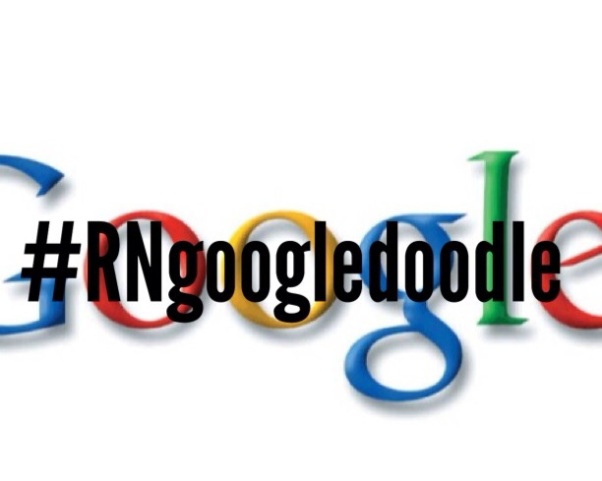Why Nurses Need A Google Doodle
National Nurses Day is less than a month away, and I’m not excited about it. I’ve received one too many “Code Brown Queen” cards in the span of my career. More frequently celebrated with cheesy, tongue-in-cheek gifts than genuine recognition of the achievement, skill and accomplishments of its 3.1 million members, this nurse wonders if it isn’t time to change things up on May 6th.
I don’t know about you, but I’ll pass on the joke-y cards, magnets and sweatshirts. I don’t need the swag or even the extra attention; I’m just doing the job I feel called to, after all. But since the holiday exists, I think we should use it as an opportunity to actually further the visibility of the nursing profession in a proactive and intelligent manner.
So, this year, I’m asking for the Nurses Week gift I actually want: Nurses and their supporters to demand a National Nurses Day Google Doodle.
Maybe, if the millions of Americans Googling something on May 6th saw a tribute to modern day nursing, we’d be able to start a conversation about our profession that’s long overdue.
The Google Doodle team calls for suggestions that “celebrate interesting events and anniversaries that reflect Google’s personality and love for innovation.” Nursing was founded on the laurels of individuals who changed the course of medicine, and continues on the backs of nurses who daily care for and protect millions of lives through creative troubleshooting, critical thinking, and fast-paced decisions. Florence Nightingale practically discovered germ theory, most modern-day hospital procedure is based on nursing research, and any nurse who has worked short-staffed, survived the shift by relying on innovation.
So why hasn’t Google celebrated us since they started doodling 14 years ago? (To be fair, they did a small, somewhat belittling doodle for Nightingale’s birthday in 2008).
I don’t blame Google for neglecting us every year, exactly. The trouble with us nurses, is we don’t talk about what we do. Our creativity and guile and innovative genius lays locked within the halls of our practice. The tiny work-arounds we find and share with each other at the bedside change lives, but are rarely known by anyone but nurses, much less understood publicly. Nursing research, although utilized in almost every existing medical decision and implemented at the Federal level, is often poo-pooed as a soft science. And for some reason, we can’t manage to break into Hollywood as anything but drug abusers or tyrants. We’re largely missing from policy debates, few of us have paced the floors of Congress, and the pages of our newspapers are void of our heroic stories and focused opinions. It’s time we start sharing what we do in a way that those we serve can understand.
With our foundations and our future in mind, I think nurses – all 3.1 million of us – as American innovators, need a shout out from Google, the portal of the universe, this National Nurses Day. Maybe, when we’re showcased on the most innovative website on the internet, our country will realize how much we deserve to be there, and we will start actively telling them why.
So, here’s my plan: Starting this Sunday, I’ve e-mailed the Google Doodlers a suggestion for a doodle celebrating modern-day, living American nurses, calling attention to our innate innovative spirit. In each e-mail, I’m showcasing a living nurse innovator. Sunday, I wrote about Cathy Papia, a nurse from my hometown of Buffalo, who started the White Wreath Protocol, a simple way to alleviate the suffering that comes along with dying in an ICU when a hospice unit is unavailable. Monday, I told the doodlers about Mary Wakefield, the Obama-appointed administrator of the HRSA. Yesterday, doodlers got a briefing on the profoundly innovative contribution of UCSF’s Living Legend, Patricia Benner, and today, I reminded them of Carol Gino, whose voice has peppered the profession with innovative narrative for decades.
Tune in, and share: I’m posting the e-mails I send to the Google Doodle team on my blog, This Nurse Wonders, and I’ll re-hash here, on the Facebook page, Why Nurses Need A Google Doodle, and via @12HourRN.
Nurses are amazing, multi-faceted clinicians, inventors, policy makers, artists, problem-solvers and care-givers. Long before Google became a verb, “nurse” entered the language of the globe and changed it forever. We’re still here to tell our tales; perhaps Google will give us a boost.
National Nurses Day is less than a





 Internet use and broadband adoption among seniors each fall off notably starting at approximately age 75. Some 68% of Americans in their early 70s go online, and 55% have broadband at home. In contrast, internet adoption falls to 47% and broadband adoption falls to 34% among 75-79 year olds. Income also impacts use of technology. Among seniors with an annual household income of $75,000 or more, 90% go online and 82% have broadband at home. For seniors earning less than $30,000 annually, 39% go online and 25% have broadband at home.
Internet use and broadband adoption among seniors each fall off notably starting at approximately age 75. Some 68% of Americans in their early 70s go online, and 55% have broadband at home. In contrast, internet adoption falls to 47% and broadband adoption falls to 34% among 75-79 year olds. Income also impacts use of technology. Among seniors with an annual household income of $75,000 or more, 90% go online and 82% have broadband at home. For seniors earning less than $30,000 annually, 39% go online and 25% have broadband at home.